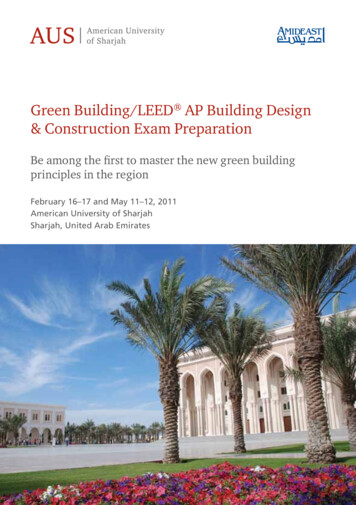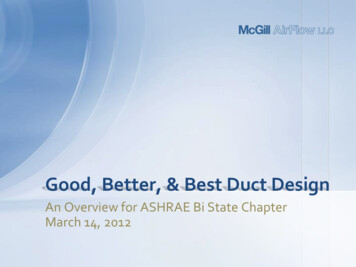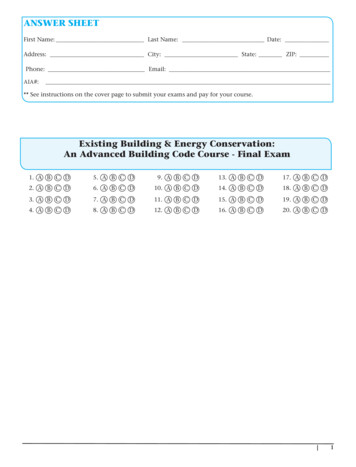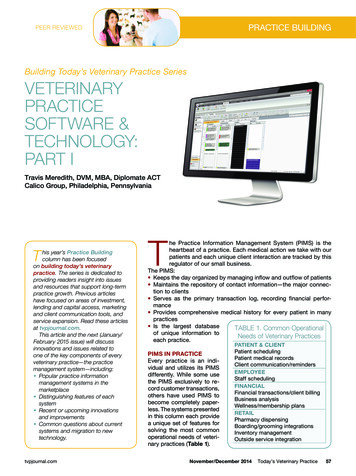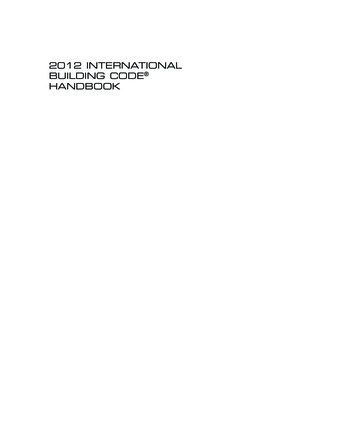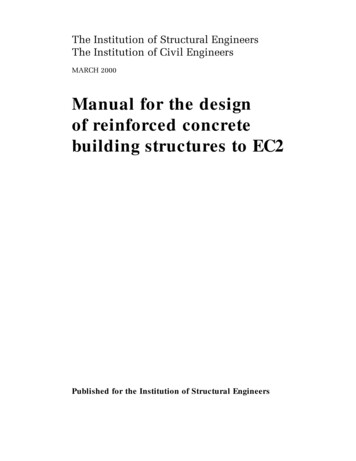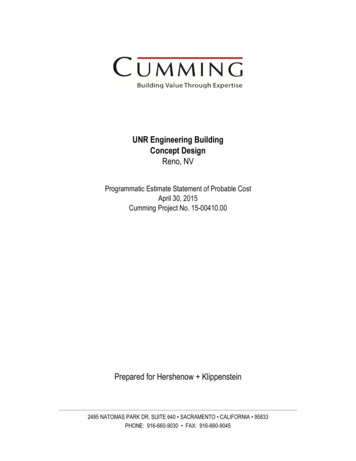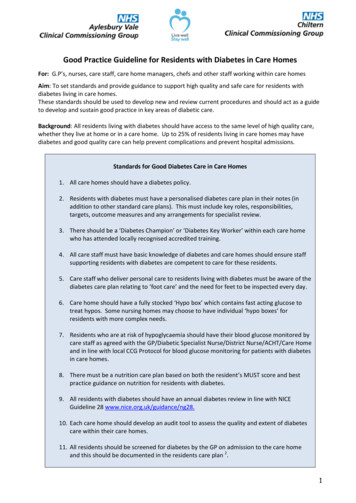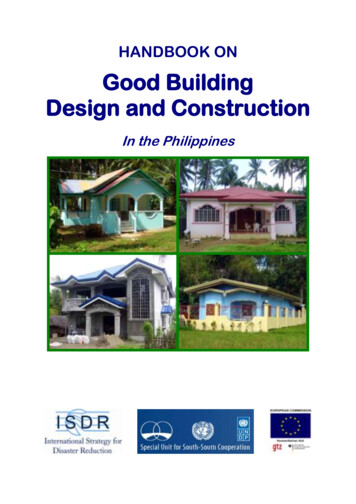
Transcription
HANDBOOK ONGood BuildingDesign and ConstructionIn the Philippines
HANDBOOK ONGood BuildingDesign and ConstructionIn the PhilippinesGood Building Design and Construction HandbookPage 1
Handbook on Good Building Design and Construction in the PhilippinesCopyright 2008German Technical Cooperation (GTZ)GTZ Office Manila9th Floor, PDCP Bank CentresV.A. Rufino corner L.P. Leviste StreetsSalcedo Village, Makati CityMetro Manila, PhilippinesTel: 63 2 812 3165Fax: 63 2 753 1441Email: gtz-philippinen@ph.gtz.deWebsite: www.gtz.deUNDP Regional Centre in BangkokUnited Nations Service Building, 3rd FloorRajdamnern Nok AvenueBangkok 10200 ThailandTel: 66 2 288 2129Fax: 66 2 288 3032Email: regionalcentrebangkok@undp.orgWebsite: http://regionalcentrebangkok.undp.org.thThe Secretariat of the International Strategy for Disaster ReductionInternational Environmental House II,Chemin de Ballexert 7-9CH-12199 Geneva, SwitzerlandTel: 41 22 917 8908Fax: 41 22 917 8964Email: isdr@un.orgWebsite: www.unisdr.orgISBN:Good Building Design and Construction HandbookPage 2
Purpose of the HandbookThis Handbook is made to provide simple information to house owners,to house designers and builders, and building monitors to teachprinciples of good design and good construction in natural hazardprone areas. Thoroughly studied, they will also guide on whether torepair or rebuild damaged houses. The descriptions are followed by acode of minimum standards for construction of houses to ensurequality and a sustainable building.Since many concepts are not easy to describe, the Handbook containspictures of good practice and common bad practice to facilitateunderstanding and to indicate how to build better. The photographshave been taken of construction practices in the Philippines. ThePhilippines are generally hazard prone to the whole range of naturalhazards, like earthquakes, landslides and flooding due to storms andsudden downpours of rain, volcanic eruption. The principles of thisbook are designed to minimize vulnerability to natural hazards, so thathouses will safeguard occupants and their assets.In an area that is prone to earthquakes and other significant naturalhazards, not only principles of design are important, but alsoprinciples of construction, since the best designed house which hasbeen well covered and painted, may hide serious structural defects inthe construction. These defects may lead to serious injury and death,and loss of property when the forces of nature strike the house.Another important element in sustainable housing is spatial planning,building houses in places that are less vulnerable, like away from riverbeds and sea shores and steep cliffs. Where houses have to be built inthese locations, design must incorporate resistance to locallyexperienced hazards.Let us develop a culture of safety in all our buildings, not just doingthe minimum and the cheapest, but building houses that willsafeguard families and assets in times of emergency.Robin D WillisonGood Building Design and Construction HandbookPage 3
ForewordsYiping ZhouDirectorSpecial Unit for South-South Cooperation, UNDPGood Building Design and Construction: the Experience of thePhilippines is the second in a series of publications dealing withthe same topic. The first one was based from the experience inAceh and Nias, Sumatra, Indonesia during the rehabilitation andreconstruction process from the destruction wrought by thetsunami of December 2004. Here, we focus on the experience ofthe Philippines in the course of rebuilding and recovering from thedevastation caused by severe flooding and landslides in the pastthree years.As recent events have continued to confirm, disasters upset andnegate hard-won development gains. Disaster risks are increasingand, as awareness grows, these risks have become a major causefor concern worldwide. The fact that disasters are often the resultsof multiple, interrelated causes, means that societies havedifficulties in addressing this global issue. As a result, disasterscan have enormous, far-reaching consequences, impacting thesurvival, livelihoods and dignity of communities, particularly thepoor and the deprived, which are located mostly in developingcountries.A wealth of experience and capacity in disaster-risk reductionexists all over the world and needs to be shared with others. ThePhilippines is one source of such knowledge and information.This publication is a practical guide to the design and constructionof houses during the reconstruction phase in the aftermath of adisaster as well as during normal times.Good Building Design and Construction HandbookPage 4
The Special Unit for South-South Cooperation (SU/SSC) supportsthe sharing of knowledge, expertise and lessons learnedconcerning the enhancement of growth and development as wellas the management of disasters that derail development efforts. Inparticular, we emphasize South-to-South exchanges and strategicpartnerships to address the risk of vulnerability of poor anddeveloping countries, which often are the most affected bydisasters and the adverse effects of climate change. In 2005 at theUnited Nations High-level Committee on South-SouthCooperation, delegates from the Asia and Pacific region requestedSU/SSC to support developing countries that are vulnerable todisasters, especially the small island developing States. For thisreason, SU/SSC has been working to support the implementationof the Hyogo Framework of Action through collaboration with theInternational Strategy for Disaster Reduction (ISDR) and withother organizations through the development and publication ofknowledge products on disaster reduction and management.We in the Special Unit are proud to have a role in this publicationalong with ISDR and the German Agency for TechnicalCooperation (GTZ). The importance of safe shelter cannot beoveremphasized. Hence, commitment to quality design andconstruction should be one of the prerequisites in reconstructionefforts. The children are the hope and future of the world and it isunthinkable for them to continue to live and learn in unsafe,poorly built houses and schools. The past tragedies hold lessonsfrom which we can all learn and it is our hope that this publicationwill help us to build better, safer places in pre- as well as postdisaster environments.Yiping ZhouDirectorSpecial Unit for South-South Cooperation, UNDPGood Building Design and Construction HandbookPage 5
Sálvano BriceñoDirectorUnited Nations Secretariat of the InternationalStrategy for Disaster ReductionClimate change, environmental degradation, and unchecked urbangrowth, are increasing the severity and frequency of disasters.This is a growing threat to lives and livelihoods, and a seriouschallenge for socioeconomic development in many countries.Against the backdrop of these global trends, the secretariat of theInternational Strategy for Disaster Reduction (UN/ISDR) seeks tostrengthen the exchange of concrete experience and knowledge ofcommunity-based risk reduction. Practical, simple steps like thispublication, which shares clear, useful examples on how todecrease disaster risk at the grassroots, are vital to strengtheningthe disaster resilience of not only houses, but entire communitiesand nations.The Philippines is regularly exposed to climate-related hazardssuch as intensifying typhoons and floods, as well as seismic andvolcanic events that have affected whole regions of the country.In 2006 the Philippines experienced a devastating typhoon seasonwhich damaged and destroyed hundreds of thousands of homes,and affected eight million people. However, the experiences ofthe Philippines, as a disaster-prone country, can serve not just as awarning of the damage that is done by vulnerability to hazards,but as a showcase of the opportunities for integrating disaster riskreduction into the recovery process.This handbook on ‘Good Building Design and Construction in thePhilippines’ does exactly that, capturing the potential of increasedresilience through good construction. The UN/ISDR secretariat issupporting the development and distribution of tools like thishandbook, as a part of its mandate for coordinating theGood Building Design and Construction HandbookPage 6
implementation of the Hyogo Framework for Action. In 2005,just after the Indian Ocean Tsunami, 168 governments adopted theHyogo Framework for Action, in an acknowledgement of the needto build back better, to increase disaster resilience bymainstreaming disaster risk reduction into development, and toavoid the recreation of past mistakes.At the international level, UN/ISDR secretariat, in partnershipwith the UNDP, ILO, World Bank, and the governments of Italy,Japan and Switzerland, have established the InternationalRecovery Platform, which provides guidance for building backbetter from disasters. At the community level, UN/ISDRsecretariat is also actively engaged in supporting partners,particularly NGOs and local authorities, in reconstructionprocesses, to ensure the integration of risk reduction into therebuilding of houses, schools, and health facilities.Complementing our work, this handbook explains basic but vitalprinciples of design and construction that can withstand naturalhazards, in clear, easy to understand language, and withphotographic examples of good and bad practices. Forcommunities that are building back from disaster, or committed tobuilding resilience in these times of increasing disaster risk, thishandbook should be the one of the first tools out of the box. Tomake this happen, the handbook, and tools like it, should bewidely translated and made available to UN country offices, andnational and local governments to learn from, in order to makedisaster recovery efforts more effective and sustainable.Sálvano BriceñoDirector, United Nations Secretariat of the International Strategy forDisaster ReductionGood Building Design and Construction HandbookPage 7
Jochem LangeGerman Technical Cooperation (GTZ)Country Director for the Philippines and the PacificSome areas of the world are especially exposed to naturalhazards. One such location is the Philippines as part of thePacific “Ring of Fire” and a major recipient of tropicalstorms hitting the country from the Pacific Ocean. Thevulnerability of the country was demonstrated repeatedlyby volcano eruptions like that of the Pinatubo in 1991, theflashflood in Ormoc the same year, many land- andmudslides in the western part of the country and the bigearthquake in Baguio (magnitude 7.7) in 1990. Thousandsdied or were injured due, in part, to limited understandingof prevention, mitigation and preparedness for disasters.Had people known more about risk reduction, largenumbers of injuries, death and damage to assets couldhave been avoided.The importance of analyzing hazards carefully andintegrating measures to reduce their impact in land useplanning and in building codes cannot be overemphasized.Taking the risks of landslides, floods and tsunamis intoaccount, spatial planning of human settlements, both,residential and commercial, is the key to taking people outof harm’s way. In some cases resettlement might be theonly option for homes in extreme hazard areas. It is simplynot acceptable to continue living under the constantthreat of a major disaster.Shelter is a basic human need. A house protects from theclimate and animals, and it also has a socio-cultural roleas the centre of the family life and as a manifestation ofGood Building Design and Construction HandbookPage 8
self-identity. A well designed and built house is a housethat supports the lifestyle of the dweller, and a wellconstructed house protects the lives of the residents.Many of the existing houses in the Philippines are still notsafe enough to withstand the recurring forces of natureand GTZ is pleased to publish this Handbook as an aid toassist local communities to design and build strongerhouses in safe locations. This will help them to withstandextreme weather and geological events. It is written withthe aim of making technical information simple andunderstandable for those who build so many of the homes:the homeowners themselves.Jochem LangeCountry Director for the Philippines and the PacificGerman Technical Cooperation (GTZ)Good Building Design and Construction HandbookPage 9
AcknowledgementsMr. Robin Willison, Disaster Risk Reduction Consultant and aCivil Engineer, researched and wrote the text and took thephotographs for this Handbook, developed through experiencein recovery from tragedy caused by impacts of hazards fromnature in Indonesia and the Philippines.The development and publishing of this Handbook to promotebetter practice in building houses in the Philippines was theinitiative of the Environment and Rural Development program ofGTZ, supported by UNISDR and the Special Unit for South-SouthCooperation of UNDP. Mr. Olaf Neussner, disaster riskconsultant to GTZ provided support for assessing the buildingculture in Leyte and Samar and study of the effect of localcatastrophes.Good Building Design and Construction HandbookPage 10
ContentsPurpose of the HandbookForewordsAcknowledgements3410Design Principles1. Foundations2. The building needs a coherent structure3. Joining walls to roof structure4. Tying walls to building structure5. Roof truss ties6. Cross bracing of walls and roof7. Drainage principles8. House elevation and location121317263238414445Construction and Materials Principles1. Foundations2. Sand and gravel3. Mixing concrete4. Making columns5. Reinforcement6. Roofing7. Tying walls to structure8. Wells, septic tanks, plumbing495155616266687275Code of minimum standards for house building77House Building Checklist82Good Building Design and Construction HandbookPage 11
Design PrinciplesSummary DescriptionTo meet the cultural, social, and physical requirements ofthe residents, and to provide a safe dwelling to shelterthem from the hazards that may impact from theirenvironment, a house must be proper
Good Building Design and Construction Handbook Page 3 Purpose of the Handbook This Handbook is made to provide simple information to house owners, to house designers and builders, and building monitors to teach
